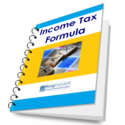ITR2 is meant for people having income from salary, income from other sources, income from capital gains and income from house property.
Thus, there is a lot of information to be filled in ITR2. Let’s see step by step instructions on filling this income tax return form ITR2.
| In “How to fill Income Tax Return Form 1 (ITR1) – Instructions and Video Tutorial”, we saw how to fill Income Tax Return Form ITR1. ITR2 covers two more heads of income (income from capital gains and income from house property), and therefore, needs more information from the income tax assessee than ITR1. |
There are many fields in common between ITR1 and ITR2 – for these fields, please see the article or the video “How to fill Income Tax Return Form 1 (ITR1) – Instructions and Video Tutorial”.
Let’s understand the extra fields from ITR2. (Please note that only the fields not there in ITR1 are explained here)
(To download Income Tax Return Forms for free, please go to “Income Tax (IT) Return Filing – Which ITR form to use?“)
Part B – TI – Computation of Total Income
2. Income from House Property
Here, you need to put the income that you have earned from your house(s).
The taxable income from your house property is calculated in schedule HP of ITR2 (we would come to that later), so just put the amount from box 3c of schedule HP here.
3 (a) (i) Short Term Capital Gain (u/s 111A) (STCG)
This is STCG made on sale of securities that are covered by the Securities Transaction Tax, or STT. These would include exchange traded stocks and equity mutual funds.
Put the amount from box A5 of schedule CG here.
3 (a) (ii) Short Term Capital Gain (Other) (STCG)
This is STCG made on sale of securities that are not covered by the Securities Transaction Tax, or STT. Put the amount from box A4 of schedule CG here.
3 (a) (iii) Short Term Capital Gain (STCG)
Add amounts from 3ai and 3aii, and put it in 3aiii.
3 (b) Long Term Capital Gain (LTCG)
Put your LTCG here – Put the amount from box B5 of schedule CG.
3 (c) Total Capital Gains
Add the amounts from boxes 3aiii and 3b, and put it in box 3c.
6 Losses of current year set off against 5
If you want to set off any loss from the current year against the income for the current year, put it in box 6.
This amount would come from a sum of amounts in boxes 2vi and 3 vi of schedule CYLA of ITR2.
(Want to know more about set off and carry forward of losses? Please read “Set Off and Carry Forward of Losses – Capital Gains and House Property”)
7 Balance after set off current year losses
The amount in box 5 is your total taxable income for the year. Subtract the amount in box 6 from the amount in box 5, and put it in box 7.
8 Brought forward losses set off against 7
If you have losses brought forward from previous year(s), you need to mention them here. Put the amount from box 2vi of schedule BFLA here.
9 Gross Total Income
Subtract the amount in box 8 from the amount in box 7, and put it in box 9.
10 Deductions under chapter VI-A
This amount would come from box n of schedule VIA.
14 Losses of current year to be carried forward
If you have losses from the current year that could not be set off against income from the current year, you can carry them forward to the next year.
Put the amount from box xi of schedule CFL here.
Part B – TTI – Computation of Tax Liability on Total Income
This section is exactly as it is in ITR1. Please see “How to fill Income Tax Return Form 1 (ITR1) – Instructions and Video Tutorial” for more details.
Schedule S – Details of Income from Salary
1 Salary
Put your salary here. It should be your salary excluding all allowances, perks (perquisites) and profit in lieu of salary. You would get this amount from your Form 16.
2 Allowances Exempt under section 10
There are many allowances that would fall here, but the main item for most of us would be House Rent Allowance (HRA), transport allowance and Leave Travel Allowance (LTA).
Other things falling here would be scholarships granted to meet the cost of education, uniform allowance (Rs. 10,000 per year), children’s education allowance (Rs. 1,200 per year per child for upto 2 children), etc.
3 Allowances not exempt
Put the amount of all other allowances here.
4 Value of perquisites
If you are provided perquisites by your employer (like housing, free or concessional education, etc), you need to put their value here.
5 Profits in lieu of salary
If you have received any amount from your employer as a substitute for your salary, please mention it here.
An example of this would be notice pay received by you if you are terminated from your job and receive some months’ salary instead of being able to serve the notice period.
6 Income chargeable under the head Salaries
This would be the sum of amounts in boxes 1, 3, 4 and 5. Put it in box 6.
Schedule HP – Details of income from house property
1a Annual letable value / rent received or receivable
If you have received rent from your apartment or house, please mention it here.
If you have more than one house, and none is given out on rent, one of the houses is treated as if it is given out on rent. If this is the case, please put the annual letable value of the house here. This is the rent you can receive if the house is given out on rent.
1b The amount of rent which cannot be realized
This is the rent that you were not able to get from the tenant.
1c Tax paid to local authorities
If you have paid any taxes to the local authorities, please put the amount here.
1d Total
Add amounts in boxes 1b and 1c, and put it in box 1d.
1e Balance
Subtract the amount in 1d from 1a, and put it in 1e.
1f 30% of 1e
Calculate 30% of the amount in 1e, and put it in 1f.
This is the basic exemption that you get against your income from house property.
1g Interest payable on borrowed capital
If you have taken a loan for buying this house (home loan), and are paying interest on it, indicate the amount here. Also include any portion of per-EMI interest that you are claiming.
(For more information on income tax benefits of a home loan, please read “Income Tax (IT) Benefits of a Home Loan / Housing Loan / Mortgage”)
1h Total
Add 1f and 1g, and out it in 1h.
1i Income from house property
Subtract 1h from 1e, and put it in 1i. This is your total income from house property 1.
If you need to indicate income from another house, repeat these steps (2a to 2i)
3a Rent of earlier years realized under section 25A/AA
If there was rent in previous years that could not be realized, and has been realized in this year, please put it in 3a. This should be included here even if you are no longer the owner of that house.
3b Arrears of rent received during the year under section 25B after deducting 30%
If you receive extra rent for past years in the current year, please include the amount here after reducing it by 30%. Again, this should be included here even if you are no longer the owner of that house.
3c Total
Add 3a, 3b, 1i and 2i, and put it in 3c. This is your income under the head “income from house property”.
Schedule CG – Capital Gains
A. Short Term Capital Gain (STCG)
1 From assets in case of non-resident to which first proviso to section 48 is applicable
This is when the STCG rules for resident Indians also apply to non-residents. If this is applicable to you, pleas put the amount in box 1.
2 From other assets
a Full value of consideration: This is the amount you received from the sale of the asset.
b Deduction under section 48:
i Cost of acquisition: This is the amount you paid for the purchase of the asset. Put it in box bi.
ii Cost of Improvement: This is the amount you paid for the improvement of the asset. Put it in box bii.
iii Expenditure on transfer: This is the cost you incurred for transferring the asset. Put it in box biii.
iv Total: Add bi, bii and biii, and put it in biv.
c Balance
Subtract biv from 2a, and put it in 2c.
d Loss, if any, to be ignored under section 94(7) or 94(8):
This is about loss arising from dividend stripping – such loss is not permissible as a loss, and has to be mentioned here.
e Exemption under section 54B / 54D
This is to mention capital gain arising out of transfer of agricultural land or from compulsory acquisition of land / building of an industry.
Such a gain is exempt from tax, and should be mentioned here.
f Short-term capital gain
Add 2c and 2d, and subtract 2e from it. Put this in 2f. This is your short term capital gain.
3 Amount deemed to be short term capital gains under section 54B / 54D / 54EC / 54ED / 54G / 54GA
Here, you need to put amounts that are deemed to be short term capital gain. Examples would be amount received on liquidation of a company, amount invested u/s 54EC withdrawn before the lock-in period, etc.
4 Total short term capital gain
Add 1, 2f and A3, and put it in A4. This is your total capital gain.
5 Short term capital gain under section 111A included in 4
If you have any STCG made on sale of securities that are covered by the Securities Transaction Tax, or STT, you need to include even that in this STCG calculation – even if it is exempt from tax.
Mention such amount in box A5.
6 Short term capital gain other than referred to in section 111A
Subtract A5 from A4, and put it in A6.
(To download Income Tax Return Forms for free, please go to “Income Tax (IT) Return Filing – Which ITR form to use?“)
Other articles you might be interested in:
- Set Off and Carry Forward of Losses – Capital Gains and House Property
- How to save / avoid Long Term Capital Gain (LTCG) Tax on Sale of a House
- Long Term Capital Gains (LTCG) on Sale of a House – Calculation and Income Tax
- Long Term and Short Term Capital Gain – Income Tax Calculation
- How to fill Income Tax Return Form 1 (ITR1) – Instructions and Video Tutorial
- The stock market is falling – Time to invest?
- Residential / Commercial Property for a Non Resident Indian (NRI)
- An introduction to Hedge Funds
- Banks increase interest rates for deposits and lending (loans)
- Matthews India Fund MINDX: A good proxy to invest in India
- Why does the financial / fiscal year start from 1st April?
- Tata AIG – Maharaksha Accident and Injury Policy
| B. Long Term Capital Gain (LTCG) 1 Assets in case of non-resident to which first proviso to section 48 is applicable This is when the LTCG rules for resident Indians also apply to non-residents. If this is applicable to you, pleas put the amount in box 1. |
2 From other assets where proviso to section 112 (1) is not applicable
This is assets where you want to claim the indexation benefit.
(To download Income Tax Return Forms for free, please go to “Income Tax (IT) Return Filing – Which ITR form to use?“)
a Full value of consideration: This is the amount you received from the sale of the asset.
b Deduction under section 48:
i Cost of acquisition after indexation: This is the amount you paid for the purchase of the asset, indexed for inflation using cost inflation index numbers. Put it in box bi.
ii Cost of improvement after indexation: This is the amount you paid for the improvement of the asset, indexed for inflation using cost inflation index numbers. Put it in box bii.
(To know more about saving LTCG by using indexation, please read “Long Term Capital Gains (LTCG) on Sale of a House – Calculation and Income Tax”)
iii Expenditure on transfer: This is the cost you incurred for transferring the asset. Put it in box biii.
iv Total: Add bi, bii and biii, and put it in biv.
c Balance
Subtract biv from 2a, and put it in 2c.
d Exemption under section 54 / 54B / 54D / 54EC / 54F / 54G / 54GA
If you have to claim exemption of LTCG under any of these sections, put it in box 2d.
e Net Balance
Subtract 2d from 2c, and put it in 2e.
3 From other assets where proviso to section 112 (1) is applicable
This is assets where you do not want to claim the indexation benefit.
a Full value of consideration: This is the amount you received from the sale of the asset.
b Deduction under section 48:
i Cost of acquisition without indexation: This is the amount you paid for the purchase of the asset, without indexing it for inflation using cost inflation index numbers. Put it in box bi.
ii Cost of improvement without indexation: This is the amount you paid for the improvement of the asset, without indexing it for inflation using cost inflation index numbers. Put it in box bii.
iii Expenditure on transfer: This is the cost you incurred for transferring the asset. Put it in box biii.
iv Total: Add bi, bii and biii, and put it in biv.
c Balance
Subtract biv from 3a, and put it in 3c.
d Exemption under section 54 / 54B / 54D / 54EC / 54F
If you have to claim exemption of LTCG under any of these sections, put it in box 3d.
e Net balance
Subtract 3d from 3c, and put it in 3e.
4 Amount deemed to be long term capital gains under sections 54 / 54B / 54D / 54EC / 54ED / 54F
If there is any amount deemed to be long term capital gains under any of these sections, put it here.
5 Total LTCG
Add 1, 2e, 3e and 4, and put it in B5.
If the amounts in 2e and / or 3e are losses, treat them as zero here. That is, do not subtract!
C. Income chargeable under the head “Capital Gains”
Add A4 and B5, and put it in C.
D. Information about accrual / receipt of capital gain
Split your long term / short term capital gains depending on the date of such gains, and mention them under relevant cells in the table.
Schedule OS – Income from Other Sources
1a Dividend, Gross
If you have received any dividends, mention the amount in 1a.
1b Interest, Gross
If you have received any interest, mention the amount in 1b.
1c Rental income from machinery, plants, buildings
If you have such rental income, indicate it in 1c.
1d Others, Gross (excluding income from owning race horses)
If you have any other income, indicate it here.
e Total
Add up 1a, 1b, 1c and 1d, and put it in 1e.
f Deductions under section 57
- i Expenses: If you have any expenses, put it in fi.
- ii Depreciation: If you have any depreciation, put it in fii.
- iii Total: Add fi and fii, and put it in fiii.
g Balance
Subtract fiii from 1e, and put it in 1g.
2 Winnings from lotteries, crossword puzzles, races, etc.
If you have any such winnings, put the amount in 2.
3 Income from other sources (other than from owning race horses)
Add up 1g and 2, and put it in 3.
If amount in 1g is a loss, treat it as zero here.
4 Income from owning and maintaining race horses
- a Receipts: Put your earnings in 4a.
- b Deductions under section 57 in relation to (4): Put the amount in 4b.
- c Balance: Subtract 4b from 4a, and put it in 4c.
5 Income chargeable under the head “Income from other sources”
Add 3 and 4c, and put it in 5.
If 4c is a loss, treat it as zero here. In that case, indicate the amount in 4c in schedule CFL.
Schedule CYLA – Details of Income after set off of current year losses
This schedule is for adjusting losses from the current year. Fill up the relevant details in the respective cells of the table.
Schedule BFLA – Details of Income after set off of brought forward losses of earlier years
This schedule is for adjusting losses from the previous year(s). Fill up the relevant details in the respective cells of the table.
Schedule CFL – Details of losses to be carried forward to future years
This schedule is for carrying forward losses that could not be set off. Fill up the relevant details in the respective cells of the table.
(Want to know more about set off and carry forward of losses? Please read “Set Off and Carry Forward of Losses – Capital Gains and House Property”)
All the schedules after this in ITR2 are the same as in ITR1. Please see the article or the video “How to fill Income Tax Return Form 1 (ITR1) – Instructions and Video Tutorial” to learn more about them in detail.
(To download Income Tax Return Forms for free, please go to “Income Tax (IT) Return Filing – Which ITR form to use?“)
Other articles you might be interested in:
- Set Off and Carry Forward of Losses – Capital Gains and House Property
- How to save / avoid Long Term Capital Gain (LTCG) Tax on Sale of a House
- Long Term Capital Gains (LTCG) on Sale of a House – Calculation and Income Tax
- Long Term and Short Term Capital Gain – Income Tax Calculation
- How to fill Income Tax Return Form 1 (ITR1) – Instructions and Video Tutorial
- The stock market is falling – Time to invest?
- Residential / Commercial Property for a Non Resident Indian (NRI)
- An introduction to Hedge Funds
- Banks increase interest rates for deposits and lending (loans)
- Matthews India Fund MINDX: A good proxy to invest in India
- Why does the financial / fiscal year start from 1st April?
- Tata AIG – Maharaksha Accident and Injury Policy





